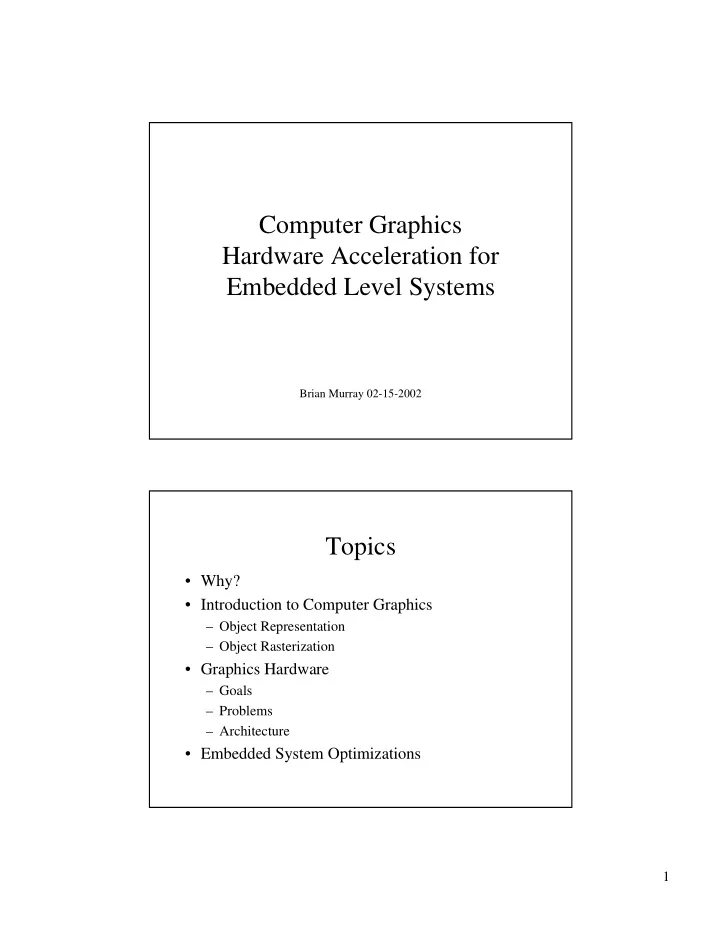

Computer Graphics Hardware Acceleration for Embedded Level Systems Brian Murray 02-15-2002 Topics • Why? • Introduction to Computer Graphics – Object Representation – Object Rasterization • Graphics Hardware – Goals – Problems – Architecture • Embedded System Optimizations 1
Object Representation • Goals – Display images to user – Be able to represent images in abstract form • Solution – Use specialized algorithms that take primitives and convert them into “pixels”. Primitive Transformations • Geometric Transformation – Move Primitives/Polygons (Triangles) to correct positions in 3D space. – Project 3D points onto 2D points • Lighting – Use lights to correctly color and shade the triangles • Rasterization – Convert the resulting objects (triangles) into pixels 2
Rasterization - Interpolation • Interpolation of Points – Use the coordinates at each point and find the points between. – Find the points between the points on the lines. Rasterization – Lighting/Shading • Phong Illumination – Position of Lights – Orientation of polygon – Position of viewer • Gouraud Shading – Interpolate colors of at the points of the triangle. lights I=I a k a + Σ [I p (k d cos θ +k s con n α )] n=0 3
Rasterization - Texturing • Map the points of a Texture on the points of a Triangle. – Each triangle point has a screen coordinate (x,y) – Each triangle point has a texture coordinate (u,v) – Use interpolation to find the points between. Rasterization – Depth Checking Frame Buffer • Z-Buffer – Stores Z values of points as it is rasterizing – Check against the Z- Buffer to find out if you are near or farther 3 2 � � � � � � � � � � 3 3 2 2 from the screen. � � � � � � � � 3 3 3 2 2 2 � � � � � � 3 3 3 3 3 2 2 2 2 – If closer, write to Z- � � � 3 3 3 3 1 1 2 2 2 2 � � Buffer and Frame- 3 3 1 1 1 1 2 2 � � � � 1 1 1 1 1 1 � � � � � � Buffer (screen) 1 1 1 1 1 1 1 1 � � � � 1 1 1 1 1 1 1 1 1 1 � � 1 1 1 1 1 1 1 1 1 1 1 1 Z Buffer 4
Graphics Hardware • Goals – Implement the functionality of graphics processing in hardware. – Speed is usually the main factor – Can be very expensive Graphics Hardware - Problems • Problems – Many Many Memory Accesses – Large amounts of Floating point math – Must be efficiently pipelined and fast – Requires large amounts of memory, especially for multiple frame-buffers. 5
Graphics Hardware – General Architecture Embedded System Concerns • Space • Memory – Cores must take up – Memory is limited minimal area • Heat • Power – Speed and power – Power constraints are demands generate heat, tight to which many systems are not tolerant • Speed – Must be fast enough to be useful 6
Embedded Solutions • Off load Geometric Transformations to CPU • Disregard Post-Rasterizer Functions • Use an asynchronous pipeline • Shut off portions not in use or already done • Try to make maximum usage of memory available • Do as many functions as possible in fixed point • Simplify architecture and make system scalable • Eliminate extra precision to minimize hardware Rasterization Solution - DDS • Sort all vertices from top to bottom • Determine the x/y “slope” of each edge • Determine the x starting point (x=slope+ceil(y)-y) • Add to x the slope at each y while moving down the screen to get beginning and ending points. • Interpolate between those points Kugler, A.. “The Setup for Triangle Rasterization”, Proceedings of the 11th Eurographics Workshop on Graphics Hardware , Poitiers, France, August 1996, pp. 49--58. 7
Fixed Point Lighting • Convert all vector math to Log(2) domain • Use 16bit vectors • Less than 1 percent color error opposed to floating point Chen, C-H; Lees, C-Y, “A cost effective lighting processor for 3D graphics application ”, Image Processing, 1999. ICIP 99. Proceedings. 1999 International Conference on, Volume: 2 , 1999 ,pp2 792 –796. Embedded Architecture1 8
Embedded Architecture2 Verification Procedures • Verification – Simulate memory accesses for cache optimization – Simulate Architecture for flow and control verification – Simulate Rasterization with fixed and floating to show possible error rates – Create a hardware model and verify with FPGA 9
Future Work • Enhance an Embedded processor for geometric transformations • Scale the system with a parallel architecture (i.e. mini-frame buffers) • Add modern features such as mip-mapping, per- pixel operations, and z-buffer compression (or pyramidal) • Cache implementations for the system : new localities and enhanced memories 10
Recommend
More recommend